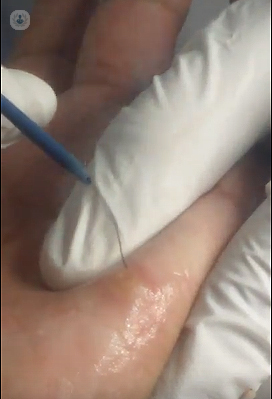

What is electrocoagulation?
Electrocoagulation is an electrosurgery technique that uses electric current to coagulate tissues that need to be eradicated, e.g. seborrhoeic keratosis, common warts and some skin diseases. It is performed under local anaesthesia. It can be performed on an outpatient basis.

Why is it done?
Electrocoagulation is a treatment used in various medical specialities. The most common use is to eliminate skin lesions such as warts and cherry angiomas in dermatology.
It is also frequently used to coagulate arteries and veins, preventing bleeding, and to remove tumours and lesions in deep locations. So, in gynaecology, the treatment is also frequently used to eliminate warts and other lesions in the cervix caused by the human papillomavirus.
What does it involve?
The electrocoagulation session, performed under local anaesthesia, involves the application of concentrated electric current with an electric scalpel. The electric current is applied to the tissue via an electrode that becomes hot and burns the tissue, thereby destroying the lesion.
The process usually lasts around 10 minutes and does not require stitches.
How to prepare for the intervention
Electrocoagulation is an outpatient treatment that does not require any particular preparation on the patient’s part.
Care following the intervention
You can resume your normal routine immediately after electrocoagulation. In most cases, patients are advised to keep the lesion dry and to protect it from sunlight. Further treatment may be required for some lesions; in such cases, you would receive instructions from the specialist.
Alternatives to electrocoagulation
The main alternative to electrocoagulation in the treatment of skin lesions is cryotherapy, a technique in which liquid nitrogen is applied to lesions, destroying them by freezing. Both hot and cold are useful agents in surgery. Cryotherapy can be used in the great majority of cases in which electrocoagulation is used. Exceptions include lesions covered by keratin because keratin does not respond effectively to freezing.
